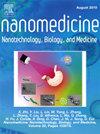金纳米颗粒与卵清蛋白作为辅助剂在口服耐受的间接作用中改善小鼠耳伤口愈合
IF 4.6
2区 医学
Q2 MEDICINE, RESEARCH & EXPERIMENTAL
Nanomedicine : nanotechnology, biology, and medicine
Pub Date : 2025-04-21
DOI:10.1016/j.nano.2025.102822
引用次数: 0
摘要
口服耐受抑制先前口服暴露于该蛋白的动物在抗原和佐剂免疫后产生的免疫反应,如抗体的产生。口服耐受抗原和明矾佐剂的外注射可诱导全身效应,抑制对不相关抗原的免疫反应,并促进小鼠皮肤伤口愈合。本研究探讨了金纳米颗粒结合卵清蛋白(AuNPs@OVA)是否可以作为口服耐受的有效佐剂,促进小鼠耳部损伤修复。雄性瑞士小鼠接受5天的口服卵细胞治疗,7天后在尾基注射s.c. AuNPs@OVA,在首次给药后20天进行第二次注射。初次注射时在一只耳朵上产生病变。透射电镜(TEM)证实了AuNPs的球形形貌,平均直径约为6.84 nm。研究结果表明,AuNPs@OVA注射增强了非耐受小鼠的IgG1、IgG2a和总抗ova抗体水平。免疫接种也增加了注射部位的白细胞水平。在ova耐受小鼠中,AuNPs@OVA提高了尾部淋巴结中表达tbet细胞的百分比,但在脾脏中没有。组织学分析显示,与其他组相比,AuNPs@OVA治疗ova耐受小鼠的耳组织重塑得到改善。这些结果表明AuNPs@OVA注射剂不仅利用了口服耐受性的间接作用,而且在促进耳部伤口愈合方面也优于Al(OH)3作为佐剂。本文章由计算机程序翻译,如有差异,请以英文原文为准。

Gold nanoparticles associated with ovalbumin as adjuvant in the indirect effects of oral tolerance improve ear wound healing in mice
Oral tolerance suppresses immune responses, such as antibody production, following immunization with an antigen and adjuvant in animals previously exposed to the protein orally. Parenteral administration of orally tolerated antigens with alum adjuvants induces systemic effects that inhibit immune responses to unrelated antigens and enhance wound healing in mouse skin. This study investigated whether subcutaneous (s.c.) administration of gold nanoparticles conjugated with ovalbumin (AuNPs@OVA) could serve as an effective adjuvant in oral tolerance and promote ear lesion repair in mice. Male Swiss mice received a 5-day oral OVA treatment, followed by s.c. injections of AuNPs@OVA at the tail base 7 days later, with a secondary injection administered 20 days after the initial dose. Lesions were created on one ear during the primary injection. Transmission electron microscopy (TEM) confirmed a spherical morphology of the AuNPs, with an average diameter of approximately 6.84 nm. The findings demonstrated that AuNPs@OVA injections enhanced IgG1, IgG2a, and total anti-OVA antibody levels in non-tolerant mice. Immunization also increased leukocyte levels at the injection site. In OVA-tolerant mice, AuNPs@OVA elevated the percentage of TBET-expressing cells in the caudal lymph nodes but not in the spleen. Histological analysis revealed improved ear tissue remodeling in OVA-tolerant mice treated with AuNPs@OVA compared to other groups. These results indicate that AuNPs@OVA injections not only leverage the indirect effects of oral tolerance but also outperform Al(OH)3 as an adjuvant in promoting ear wound healing.
求助全文
通过发布文献求助,成功后即可免费获取论文全文。
去求助
来源期刊
CiteScore
11.10
自引率
0.00%
发文量
133
审稿时长
42 days
期刊介绍:
The mission of Nanomedicine: Nanotechnology, Biology, and Medicine (Nanomedicine: NBM) is to promote the emerging interdisciplinary field of nanomedicine.
Nanomedicine: NBM is an international, peer-reviewed journal presenting novel, significant, and interdisciplinary theoretical and experimental results related to nanoscience and nanotechnology in the life and health sciences. Content includes basic, translational, and clinical research addressing diagnosis, treatment, monitoring, prediction, and prevention of diseases.

 求助内容:
求助内容: 应助结果提醒方式:
应助结果提醒方式:


